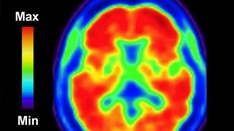Nearly half of older adults with dementia experience falls, suggests new research that also identifies multiple risk factors for these falls.
In a study of more than 5500 participants, 45.5% of those with dementia experienced one or more falls compared with 30.9% of their peers without dementia.
Vision impairment and living with a spouse were among the strongest predictors of future fall risk among participants living with dementia. Interestingly, high neighborhood social deprivation, which is reflected by such things as income and education, was associated with lower odds of falling.

Dr Safiyyah Okoye
Overall, the results highlight the need for a multidisciplinary approach to preventing falls among elderly individuals with dementia, lead author Safiyyah M. Okoye, PhD, assistant professor, College of Nursing and Health Professions, Drexel University, Philadelphia, Pennsylvania, told Medscape Medical News.
"We need to consider different dimensions and figure out how we can try to go beyond the clinic in our interactions," she said.
Okoye noted that in addition to reviewing medications that may contribute to falls and screening for vision problems, clinicians might also consider resources to improve the home environment and ensure that families have appropriate caregiving.
The findings were published online January 12 in Alzheimer's and Dementia: The Journal of the Alzheimer's Association.
No "Silver Bullet"
Every year, falls cause millions of injuries in older adults; and those with dementia are especially vulnerable. This population has twice the risk of falling and up to three times the risk of incurring serious fall-related injuries, such as fractures, the researchers note.
Falls are a leading cause of hospitalization among those with dementia. Previous evidence has shown that persons with dementia are more likely to experience negative health consequences, such as delirium, while in hospital compared to those without dementia. Even minor fall-related injuries are associated with the patient's being discharged to a nursing home rather than returning home.
Okoye stressed that many factors contribute to falls, including health status; function, such as the ability to walk and balance; medications; home environment; and activity level.
"There are multidimensional aspects, and we can't just find one silver bullet to address falls. It should be addressed comprehensively," she said.
Existing studies "overwhelmingly" focus on factors related to health and function that could be addressed in the doctor's office or with a referral, rather than on environmental and social factors, Okoye noted.
And even though the risk of falling is high among community-dwelling seniors with dementia, very few studies have addressed the risk of falls among these adults, she added.
The new analysis included a nationally representative sample of 5581 community-dwelling adults who participated in both the 2015 and 2016 National Health and Aging Trends Study (NHATS). The NHATS is a population-based survey of health and disability trends and trajectories among Americans aged 65 years and older.
During interviews, participants were asked, personally or by proxy, about falls during the previous 12 months. Having fallen at baseline was evaluated as a possible predictor of falls in the subsequent 12 months.
To determine probable dementia, researchers asked whether a doctor had ever told the participants that they had dementia or Alzheimer's disease. They also used a dementia screening questionnaire and neuropsychological tests of memory, orientation, and executive function.
Of the total sample, most (n = 5093) did not have dementia.
Physical environmental factors that were assessed included conditions at home, such as clutter, tripping hazards, and structural issues, as well as neighborhood social and economic deprivation ― such as income, education levels, and employment status.
Fall Rates and Counterintuitive Findings
Results showed that significantly more of those with dementia than without experienced one or more falls (45.5% vs 30.9%; P < .001).
In addition, a history of falling was significantly associated with subsequent falls among those with dementia (odds ratio [OR], 6.20; 95% CI, 3.81 – 10.09), as was vision impairment (OR, 2.22; 95% CI, 1.12 – 4.40) and living with a spouse vs alone (OR, 2.43; 95% CI, 1.09 – 5.43).
A possible explanation for higher fall risk among those living with a partner is that those living alone usually have better functioning, the investigators note. Also, live-in partners tend to be of a similar age as the person with dementia and may have challenges of their own.
Interestingly, high neighborhood social deprivation was associated with lower odds of falling (OR, 0.55 for the highest deprivation scores; 95% CI, 0.31 – 0.98), a finding Okoye said was "counterintuitive."
This result could be related to the social environment, she noted. "Maybe there are more people around in the house, more people with eyes on the person, or more people in the community who know the person. Despite the low economic resources, there could be social resources there," she said.
The new findings underscore the idea that falling is a multidimensional phenomenon among older adults with dementia as well as those without dementia, Okoye noted.
Doctors can play a role in reducing falls among patients with dementia by asking about falls, possibly eliminating medications that are associated with risk of falling, and screening for and correcting vision and hearing impairments, she suggested.
They may also help determine household hazards for a patient, such as clutter and poor lighting, and ensure that these are addressed, Okoye added.
No Surprise
Commenting for Medscape Medical News, David S. Knopman, MD, a clinical neurologist at Mayo Clinic, Rochester, Minnesota, said the finding that visual impairment and a prior history of falling are predictive of subsequent falls "comes as no surprise."
Knopman, whose research focuses on late-life cognitive disorders, was not involved with the current study.
Risk reduction is "of course" a key management goal, he said. "Vigilance and optimizing the patient's living space to reduce fall risks are the major strategies," he added.
Knopman reiterated that falls among those with dementia are associated with higher mortality and often lead to loss of the capacity to live outside of an institution.
The study was supported by the National Institute on Aging. The investigators and Knopman report no relevant financial relationships.
Alzheimers Dement. Published online January 12, 2023. Abstract
For more Medscape Psychiatry news, join us on Facebook and Twitter.
Credits:
Lead Image: Sorapop Udomsri/Dreamstime
Image 1: Larry Canner
Medscape Medical News © 2023
Cite this: Nearly 50% of Patients With Dementia Experience Falls - Medscape - Jan 12, 2023.











Comments